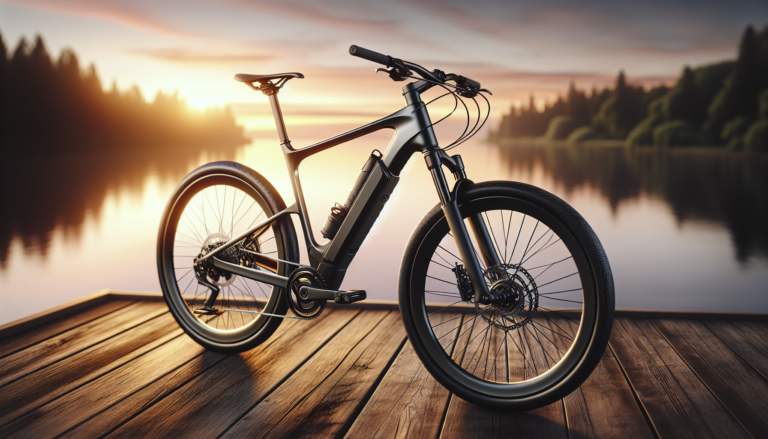What is a Hybrid Bike?
A hybrid bike is a versatile and popular style of bicycle that combines features from both road bikes and mountain bikes. This unique blend of characteristics makes hybrid bikes suitable for a wide range of riding conditions, from smooth pavement to light off-road trails. Whether you’re commuting to work, running errands around town, or enjoying a casual weekend ride, a hybrid bike can be an excellent choice.
Definition and Overview
At its core, a hybrid bike is designed to provide a comfortable, efficient, and adaptable riding experience. The term “hybrid” refers to the way these bikes merge key elements from road bikes, touring bikes, and mountain bikes. By combining a lightweight frame, flat handlebars, wide-range gearing, and medium-width tires with a semi-smooth tread, hybrid bikes offer a balanced performance that’s well-suited for general-purpose riding.
One of the primary benefits of a hybrid bike is its upright riding position. The flat handlebars and relaxed frame geometry allow riders to sit up straighter, which reduces strain on the back, shoulders, and wrists. This comfortable posture is especially advantageous for those who may experience discomfort in the more aggressive, forward-leaning position of a road bike.
History and Evolution
The concept of the hybrid bike emerged in the late 1980s and early 1990s as cyclists sought a more versatile alternative to the specialized road and mountain bikes that dominated the market. Early hybrids were essentially road bikes with flat handlebars, wider tires, and a more upright riding position. As the category evolved, manufacturers began incorporating features from other bike styles to enhance comfort, stability, and performance.
Over time, hybrid bikes have become increasingly diverse, with sub-categories that cater to specific riding preferences and needs. Some models prioritize speed and efficiency, utilizing lighter frames and components similar to those found on road bikes. Others focus on comfort and stability, incorporating suspension forks, wider tires, and even racks or fenders for utility. The growing popularity of hybrid bikes has also led to the development of electric-assist versions, which provide an extra boost for longer distances or hilly terrain.
Key Features of Hybrid Bikes
To better understand what sets hybrid bikes apart from other bicycle types, let’s take a closer look at some of their key features and components.
Frame Materials
Hybrid bike frames are typically made from one of three materials: aluminum, steel, or carbon fiber. Aluminum is the most common choice, as it provides a good balance of strength, light weight, and affordability. Steel frames are known for their durability and smooth ride quality, but they tend to be heavier than aluminum. Carbon fiber is the lightest and most expensive option, offering excellent vibration damping properties and a high-end appearance.
Wheel Sizes
Most hybrid bikes use either 700c (29-inch) or 26-inch wheels. 700c wheels are the same size as those found on road bikes, and they offer excellent rollover ability and maintain speed well on paved surfaces. 26-inch wheels, on the other hand, are smaller in diameter and provide better maneuverability and acceleration. They are more commonly found on hybrid bikes with smaller frame sizes or those designed for off-road use.
Handlebars and Riding Position
One of the defining characteristics of a hybrid bike is its flat handlebar design. Unlike the curved drop bars found on road bikes, flat bars allow for a more upright and relaxed riding position. This setup reduces strain on the back, neck, and shoulders, making it more comfortable for casual and leisure riding. Some hybrid bikes also feature riser bars or adjustable stems that enable riders to fine-tune their position for optimal comfort.
Gearing Options
Hybrid bikes typically offer a wide range of gearing options to accommodate various terrain and riding styles. Most models are equipped with a triple chainset (three front chainrings) and a rear cassette with 7 to 11 sprockets. This configuration provides a broad range of gears, making it easier to tackle hills and headwinds. Some hybrid bikes also offer hub gears or single-speed drivetrains for simplicity and low maintenance.
| Drivetrain Type | Characteristics | Advantages |
|---|---|---|
| Triple Chainset | 3 front chainrings, 7-11 rear sprockets | Wide gear range, versatility |
| Hub Gears | Internal gear hub with 3-8 speeds | Low maintenance, reliable shifting |
| Single-Speed | One gear ratio, no shifting | Simplicity, lightweight |
Braking Systems
Hybrid bikes employ various braking systems depending on their intended use and price point. The most common options include:
- V-brakes: Linear-pull rim brakes that offer good stopping power and are easy to maintain.
- Mechanical disc brakes: Cable-actuated brakes that grip a rotor mounted to the wheel hub, providing better performance in wet conditions.
- Hydraulic disc brakes: Fluid-powered brakes that deliver the highest level of braking power and modulation, but add complexity and cost.
Suspension Options
While most hybrid bikes feature rigid frames and forks, some models incorporate suspension elements to enhance comfort and control on rough surfaces. A suspension fork, typically with 50-100mm of travel, can help absorb bumps and vibrations from the road or trail. Suspension seatposts and stems are also available as aftermarket upgrades for riders seeking additional cushioning.
Benefits of Hybrid Bikes
The unique blend of features found on hybrid bikes translates into several key benefits for riders:
Comfort and Ergonomics
The upright riding position, flat handlebars, and slightly wider saddle of a hybrid bike all contribute to a more comfortable and ergonomic experience. By reducing pressure on the hands, wrists, shoulders, and back, hybrid bikes allow riders to enjoy longer outings without undue strain or fatigue. Additionally, the wider tires and possible suspension elements help smooth out rough roads and trails, further enhancing overall comfort.
Versatility and Practicality
One of the greatest strengths of hybrid bikes is their versatility. They are equally at home on paved roads, gravel paths, and light off-road trails, making them suitable for a wide range of cycling activities. Many hybrid bikes also feature mounts for racks, fenders, and other accessories, which expand their utility for commuting, touring, or running errands. This practicality makes hybrid bikes an excellent choice for those who want a single bike that can handle multiple roles.
Ideal Use Cases
Hybrid bikes excel in several common cycling scenarios:
- Commuting: The efficiency, comfort, and cargo-carrying capacity of hybrid bikes make them well-suited for daily rides to work or school.
- Recreational riding: The relaxed positioning and stable handling of hybrids are perfect for leisurely rides on bike paths, rail trails, or country roads.
- Light touring: With the addition of racks and panniers, hybrid bikes can be used for short-to-medium distance tours on mostly paved surfaces.
Comparing Hybrid Bikes with Other Types
To further clarify the role of hybrid bikes, it’s helpful to compare them with two other popular bicycle categories: road bikes and mountain bikes.
Hybrid Bike vs Road Bike
Road bikes are designed primarily for speed and efficiency on paved surfaces. They feature lightweight frames, narrow tires, and drop handlebars that put the rider in an aerodynamic position. While road bikes excel at long-distance rides and fast group rides, they can be less comfortable and less versatile than hybrid bikes.
| Characteristic | Hybrid Bike | Road Bike |
|---|---|---|
| Riding position | Upright, relaxed | Forward-leaning, aerodynamic |
| Handlebars | Flat | Drop |
| Tire width | Medium (28-42mm) | Narrow (23-28mm) |
| Gearing | Wide range | Close-spaced |
| Weight | Moderate | Light |
Hybrid Bike vs Mountain Bike
Mountain bikes are built for rugged off-road riding, with wide, knobby tires, suspension forks (and often rear shocks), and durable components. While they offer unparalleled traction and control on rough terrain, mountain bikes can feel sluggish and inefficient on paved roads. Hybrid bikes, in contrast, provide a more balanced performance that’s better suited for mixed-surface riding.
| Characteristic | Hybrid Bike | Mountain Bike |
|---|---|---|
| Suspension | Often none, sometimes fork | Fork (and rear shock on some models) |
| Tire width | Medium (28-42mm) | Wide (2.0-2.5 inches) |
| Tire tread | Smooth or semi-smooth | Knobby |
| Gearing | Wide range | Low gears for climbing |
| Weight | Moderate | Heavy |
Choosing the Right Hybrid Bike
With so many models and variations available, selecting the ideal hybrid bike can seem daunting. However, by considering a few key factors and assessing your individual needs, you can narrow down the options and find the perfect fit.
Factors to Consider
- Riding style and intended use: Will you primarily be riding on pavement, gravel, or a mix of surfaces? Do you plan to use the bike for commuting, fitness, or leisurely rides?
- Comfort and fit: Choose a bike that allows for a comfortable, upright riding position and ensure that the frame size and geometry are appropriate for your height and body proportions.
- Gearing and drivetrain: Consider the terrain you’ll be riding and select a gearing range that will provide a suitable balance of low gears for climbing and high gears for flat or downhill sections.
- Brakes: Decide between rim brakes and disc brakes based on your budget, riding conditions (wet vs. dry), and desired level of braking performance.
- Price and value: Determine your budget and look for a bike that offers the best combination of components, features, and quality within that price range.
Popular Hybrid Bike Models
Some well-regarded hybrid bike models that cater to different riding styles and budgets include:
- Ridgeback Flight 01: An affordable and versatile model that offers a comfortable riding position and reliable components, making it a great choice for casual riders.
- Specialized Crosstrail: A high-performance hybrid with a lightweight aluminum frame, suspension fork, and hydraulic disc brakes, designed for riders who want to explore a mix of paved and unpaved surfaces.
Conclusion
Hybrid bikes offer a unique combination of features and benefits that make them an attractive choice for a wide range of cyclists. By blending elements from road, mountain, and touring bikes, hybrids provide a comfortable, efficient, and versatile riding experience that’s well-suited for commuting, leisure riding, and light off-road exploration.
When selecting a hybrid bike, consider your individual riding style, comfort preferences, and intended use. By assessing factors such as frame material, gearing, brakes, and wheel size, you can find a model that best fits your needs and budget.
Ultimately, the key to enjoying your hybrid bike is to choose a setup that inspires confidence, comfort, and the desire to ride more often. Whether you’re navigating city streets, cruising on bike paths, or venturing onto light trails, a well-matched hybrid bike can be a reliable and enjoyable companion for all your cycling adventures.






